
Stag beetles are a family of about 1,200 species of beetles in the family Lucanidae, currently classified in four subfamilies. Some species grow to over 12 centimetres, but most to about 5 cm (2 in).
The false stag beetles (Diphyllostoma) are a group of three species of rare beetles known only from California. Almost nothing is known of their life history beyond that the adults are diurnal and females are flightless; larvae have not been observed.
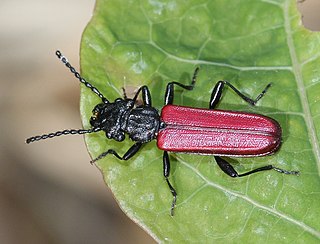
The Cucujidae, "flat bark beetles," are a family of distinctively flat beetles found worldwide under the bark of dead trees. The family has received considerable taxonomic attention in recent years and now consists of 70 species distributed in five genera. It was indicated Cucujus species are scavengers, only feeding on pupae and larvae of other insects and on other subcortical beetles such as their own. Since the Cucujidae prey on larvae of potentially tree damaging beetles that spread fungal diseases, they are considered to be beneficial to the health of living trees.

Scarabaeoidea is a superfamily of beetles, the only subgroup of the infraorder Scarabaeiformia. Around 35,000 species are placed in this superfamily and some 200 new species are described each year. Its constituent families are also undergoing revision presently, and the family list below is only preliminary.
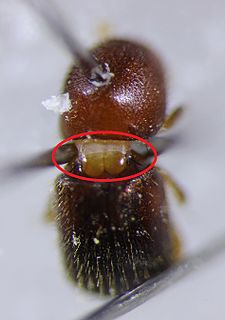
The term mycangium is used in biology for special structures on the body of an animal that are adapted for the transport of symbiotic fungi. This is seen in many xylophagous insects, which apparently derive much of their nutrition from the digestion of various fungi that are growing amidst the wood fibers. In some cases, as in ambrosia beetles, the fungi are the sole food, and the excavations in the wood are simply to make a suitable microenvironment for the fungus to grow. In other cases, wood tissue is the main food, and fungi weaken the defense response from the host plant.
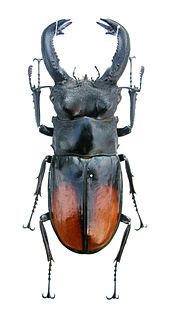
The Lucaninae comprise the largest subfamily of the stag beetles (Lucanidae).
Jean-Pierre Lacroix (1938–1989) was a French entomologist.
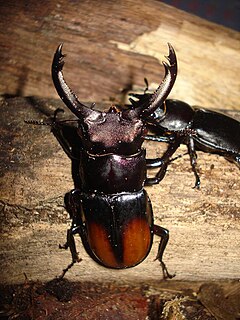
Hexarthrius is a genus of large stag beetles. They are also known as fork horned stag beetles for the shape for their mandibles It includes the following species:

Odontolabis is a genus of beetles belonging to the family Lucanidae.

Lamprima is a genus of beetles in the family Lucanidae that contains five species. They are found in Australasia.

The golden stag beetle is a species of beetles in the family Lucanidae. In Tasmania, this species is referred to by the "common name" of Christmas beetle, a name that is normally used for beetles in the family Scarabaeidae, genus Anoplognathus.

Leptinopterus tibialis is a species of beetles belonging to the family Lucanidae.

The Spilopyrinae are a small subfamily of the leaf beetles, or Chrysomelidae. They occur in Australia, New Guinea, New Caledonia and Chile. They were formerly considered a tribe of the subfamily Eumolpinae. The group was elevated to subfamily rank by C. A. M. Reid in 2000. However, some authors have criticised this placement, preferring to retain them within the Eumolpinae.
Safrina is a genus of stag beetles that are endemic to Australia.

Apterocyclus is a genus of rare stag beetles in the family Lucanidae. There are about five described species in Apterocyclus. The species of Apterocyclus are found only on the island of Kauai in the Hawaiian Islands, and are the only scarabaeoid beetles native to the Hawaiian Islands.
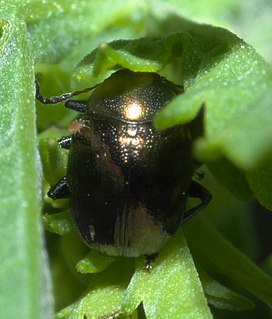
Eumolpini is a tribe of leaf beetles in the subfamily Eumolpinae. It is the largest tribe in the subfamily, with approximately 170 genera found worldwide. Members of the tribe almost always have a longitudinal median groove on the pygidium, which possibly helps to keep the elytra locked at rest. They also generally have a subglabrous body, as well as appendiculate pretarsal claws.
Lamprima imberbis is a species of beetle in the family Lucanidae; for much of its history it was treated as a synonym of Lamprima aurata, but was restored to independent status in 2018.
Macrolema is a genus of leaf beetles in the subfamily Spilopyrinae. It is found in Australia and New Guinea.

Paralissotes is a genus of stag beetle that are endemic to New Zealand.

Apterocyclus waterhousei is a species of stag beetle in the family Lucanidae. The rare, flightless beetle is found only on the island of Kauai in the Hawaiian Islands. It has been reported in several locations on the island in recent years.















